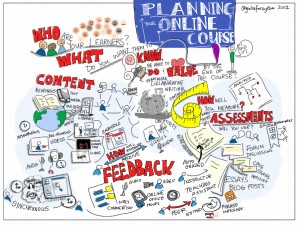 Online discussions can serve as a great opportunity for your students to reflect on the ideas presented in your course and allow them a safe place for challenging academic discourse. This blog post shares a few starting points for thinking about the format of your discussions, the roles students can play in the discussion space, and ways you can assess and incorporate the online discussions back into your face-to-face class. Illustration by Giulia Forsythe
Online discussions can serve as a great opportunity for your students to reflect on the ideas presented in your course and allow them a safe place for challenging academic discourse. This blog post shares a few starting points for thinking about the format of your discussions, the roles students can play in the discussion space, and ways you can assess and incorporate the online discussions back into your face-to-face class. Illustration by Giulia Forsythe
Format for Small Group Online Discussions
- Small groups for six to eight students per discussion group
- One student is chosen as the moderator (the moderator rotates every week on a schedule set by the faculty member)
- The moderators of all small groups meet with the faculty member the week prior to the online discussion. They collectively build the prompts and the faculty member identifies the goals for that week’s posts and any techniques to emphasize in e-moderating.
- Two deadlines for posting: First deadline is for the student to post their response to the prompt. The second deadline is for the student to reply to several other students’ prompts.
- The week after the online discussion. The moderator writes up a one page summary of the small group’s discussion and presents that in class (or online if face-to-face time is not possible).
What promotes effective online discussions?
- Make initial comments and responses in a timely way
- Display social presence: interpersonal, open, cohesive comments
- Relate readings to student’s interests/project and the discussion prompt
- There are different types of posts:
- Posts to pose questions
- Posts to respond
- Posts to connect readings or ideas in someone else’s posts.
Discussions online: Considerations
- The comments of threaded discussion are personal because of the reflection that occurs to author the post; putting the comments into a networked environment amplifies the impact of that reflection.
- Disadvantages of networked technology:
- Low frequency of responses can stifle learning
- Online discussions can carry on indefinitely
Using the Online Discussion in Face-to-Face Classes
- Use the online discussion as the springboard to a discussion in a face-to-face class.
- Using the online discussion to sort students into small group, face-to-face discussions. Use a prompt on the board that asks students to pick an answer on the scale. The prompt was a reflection on the online discussion. Based on answers (students had a choice a, b, c, d) students were sorted into groups of four to further discuss.
- Capture main ideas in a summary form. Moderators from the online discussion report back summaries of the previous week’s discussion.
Assessment
- Have students pick one post of their own to critique as a self-assessment of their participation in the online discussion.
- Sample Rubric from Garrison, D. Randy. E-learning in the 21st century: A framework for research and practice. Taylor & Francis, 2011.
